Candlesticks
Candlesticks
Candle lighting is very popular with collectors and interior designers alike. Not only decorative, it creates an intimate atmosphere at the dining table allowing friends and acquaintances to converse across the flickering lights.
Candlesticks, Candelabra & Chambersticks, Tapersticks & Wax Jacks, Snuffer Trays & Scissors
Oil Lamps, Wall Lights & Sconces, Lanterns & Chandeliers
From around AD300 to the late 18th, when oil lamps appeared, candles were the normal form of domestic lighting. They were made of tallow (animal fat) or beeswax. Wax candles were 3 times the price and indicated both wealth and social position. Candles were lit using a tinder box, or strike-a-light. A spark, struck from a flint with a steel, ignited a small quantity of flammable material. Candle flames were extinguished using a candle douter (or snuffer); either a small cone on the end of a long handle or a dual purpose scissor like tool which could both extinguish the candle flame and also cut the wick of the candle for reuse. Prior to the 19th century, when the self-consuming wick was invented, it was essential to trim the candle wick which would otherwise burn itself out. Tallow candles needed to be snuffed much more frequently than wax – 8 to 10 times an hour.
The old saying “early to bed and early to rise makes a man healthy, wealthy and wise” from Benjamin Franklin’s 18th century Almanack may have its roots in saving candlelight and thus saving money. Purchased candles were counted as luxuries even in well-to-do households.
Few domestic silver candlesticks still exist before the reign of Charles II and 17th century examples are usually made from sheet silver and are light in weight. Cast candlesticks started to appear circa 1685 and are much heavier in weight. The first loaded candlesticks appeared circa 1765 and are made of sheet silver, and not cast. Although many early candlesticks had fixed nozzles the first cast candlesticks were made without these useful drip pans. During the period c.1735-50 candlesticks with detachable nozzles appeared which facilitated much easier cleaning.
Hardly any silver candelabra survive from before the mid-18th century. Most candelabra have a detachable upper section which allows the candlesticks to be used on their own. Available in many different combinations, the smallest candelabra have just 2 arms with 2 or 3 candle lights and the largest could have an impressive 8 branches with 9 lights. In antique times candelabra use signified burning many candles at once, an expense justified only when a number of people met or when a large room had to be lighted. Nowadays candelabras are popularly used to create an intimate atmosphere at the dining table allowing friends and acquaintances to converse across the flickering lights.
Silver chambersticks first made an appearance in the 17th century and early examples are now very hard to find. Originally they were made in sets as a household would need many chambersticks. They were used for lighting the way to bed and because of the movement created when they were carried about they needed a large drip pan to catch the wax. The earliest examples have straight handles (first flat, then tubular) which were superseded in the first part of the 18th century by a ring handle. Gradually the design evolved and from the mid 18th century onwards they usually had a matching conical snuffer although from about 1790 onwards some were made with an aperture at the base of the stem to take a pair of scissor snuffers.
Silver tapersticks, averaging about 5 inches high, are miniature table candlesticks used to hold a wax taper. Tapersticks would typically be found on a desk as they were not used for lighting; the melted sticks of wax were used for sealing letters, to give a flame for tobacco pipes or to light large candles. They are rarer than candlesticks and very few existed prior to the Queen Anne period. They usually appear in singles and pairs of tapersticks command a premium price.
The silver wax jack appeared circa 1775 and was a container or frame holding a long coiled taper treated with wax (sometimes turpentine). The wax was lit to melt the sealing wax used to fasten letters and documents and usually a personal seal was pressed into the hot wax to leave a personal identification. After the wax hardened it was virtually impossible to open the letter without breaking the wax seal. The wax jack could also used as a portable light such as the chamber stick or go to bed.
Silver candle snuffers and stands. Two different types of candle douters were used to extinguish the flame of a candle. The extinguisher which was a small cone on the end of a long handle and the snuffer which was a dual purpose scissor like tool which could extinguish the candle flame and also cut the wick of the candle for reuse. There were few snuffers made prior to 1700 and by the early nineteenth century more refined candles were introduced which no longer required the wick to be cut. Additional information available at http://www.oldandinteresting.com/tallow-candles-snuffers.aspx. Snuffer trays are usually rectangular or oval shaped and can sometimes be raised on feet or have a carrying handle. Some early stands, called standing snuffers, are shaped like a candlestick with a side carrying handle and a hole at the top where the point of the snuffer scissors is inserted – these were very quickly superseded by the flat snuffer tray and scissors. It is rare now to find matching snuffers and base. Snuffers and trays were usually made by different specialists so even though the dates match, the makers will probably be different.
The 17th and 18th century lantern was very economical as it shielded the candle from the wind outside and from drafts when used inside the house, thus allowing the wax or tallow stick to burn more slowly and steadily. The archaic name, lanthorn, refers to the thin sheets of translucent horn used to fashion the sides of the early lanterns before they were made of glass.
Wall Sconces were wall lights with a back plate from which a ”branch” or candle socket extended. The back plate, usually of mirror glass or polished metal, reflected light back into a room and magnified the light from each candle. The back or wall plate also afforded some protection from drafts. The term itself comes from the old French word esconse, meaning lantern or hiding place and from the Dutch word, schans, for protection or cover.
The use of oil lamps dates back to ancient times and there are Greek and Egyptian lamps which date back to the 3rd century BC. The oil lamp was used as an alternative to candles and produced light continuously for a period of time using an oil-based fuel source. In small towns and rural areas they remained in use until well into the 20th century, until such areas were finally electrified and light bulbs could be used.
-


1686
10450 James II Antique Silver Chamberstick
Reserved
A distinctive little chamberstick (or “go to bed”) with the solid design and heavy gauge silver you’d expect from this date. It has the early form with a flat teardrop handle engraved with a family coat of arms. The circular pan has a gadrooned border and ribbed sconce, all mounted on three small stump feet. Weight 187g, 6 troy oz. Height 4.3cm. Diameter 9.7cm. Spread 15cm, 5.9ins. London 1686. Maker’s mark unclear. Sterling silver.
-

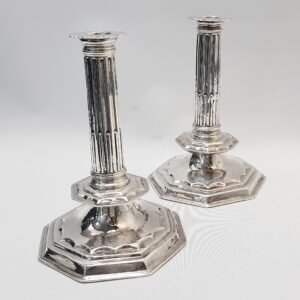
1689 - 1690
Thomas Ash
10392 William & Mary Antique Silver Candlesticks
A rare pair of early antique silver candlesticks dating from the late 1600’s. Of unusual form, these fine candlesticks stand on broad flaring octagonal bases, the fixed octagonal sconces over fluted cylindrical stems. Hand engraved below with owner’s initials “P over TE”. There are faint traces of an armorial within plumage feathers to both. Weight 725g, 23 troy oz. Height 20.5cm. Width of base 10.5cm. London 1689 and 1690. Maker Thomas Ash. Sterling silver.
-


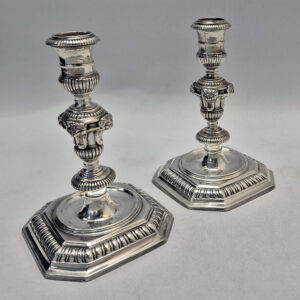
1694
John Laughton
10432 William III Antique Silver Candlesticks
Reserved
A superb pair of early English desk candlesticks with square bases and lobed, gadroon decoration. The applied lion masks are extremely charming. The technique of making cast silver sticks was introduced into England circa 1685 and this is one of the early designs. Excellent quality and heavy gauge of silver. Total weight 750g, 24.1 troy oz. Height 15.5cm. Base 10.7cm. London 1694. Maker John Laughton. Sterling silver. 17th century.
-


1695
Edward Gibson
10289 William III Antique Silver Candlesticks
A rare pair of early English silver candlesticks with square bases and lobed, gadroon decoration. Excellent quality and heavy gauge of silver. Hand engraved on the base with cypher initials below the coronet of a count (continental european). The technique of making cast silver sticks was introduced into England circa 1685 and this is one of the early designs. Weight 605 grams, 19.4 troy ounces. Height 14cm. Base 9.9cm. London 1695. Maker Edward Gibson. Sterling silver. 17th century.
-



1695
John Laughton
10433 William III Antique Silver Candlesticks
Reserved
A superb pair of early English desk candlesticks with square bases and lobed, gadroon decoration. The applied lion masks are extremely charming. The technique of making cast silver sticks was introduced into England circa 1685 and this is one of the early designs. Excellent quality and heavy gauge of silver. Total weight 750g, 24.1 troy oz. Height 15.5cm. Base 10.7cm. London 1695. Maker John Laughton. Sterling silver. 17th century.
-


1698 - 1699
Mark Paillet
10401 William III Antique Silver Candlesticks
An elegant pair of early English silver candlesticks dating from the end of the 1600’s. Solid cast silver with octagonal form, baluster columns, and a hand engraved lion crest to the faceted bases. Dwarf size, suitable for a desk. Excellent colour. Weight 446g, 14.3 troy oz. Height 14.3cm. Base 9.9cm. London 1698/99. Maker Mark Paillet, listed as Huguenot. Britannia standard silver, 95.8% purity.
-

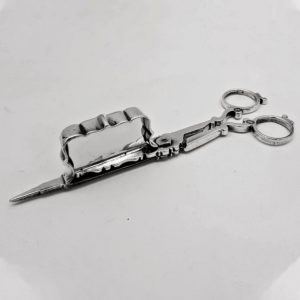
1701
Thomas Brydon
10371 William III Silver Snuffer Scissors
Sold
A rare early English silver candle douter, also called a wick trimmer, with the simple plain style typical of the period. *Britannia standard silver. Weight 94 grams, 3 troy ounces. Length 15.9cm. Width 5.5cm. London 1701. Few snuffers were made prior to 1700. Maker Thomas Brydon, see Jackson’s Silver & Gold Marks page 154, a known snuffers and stand maker.
-


1706
David Willaume
10453 Queen Anne Antique Silver Candlesticks
A beautiful pair of early English silver candlesticks. Lovely plain style in keeping with the period. Very solid and heavy cast metal with octagonal vase shaped stems over square sunken bases with canted corners. Hand engraved with a contemporary cypher below a Ducal coronet. Excellent colour. Weight 864g, 27.7 troy oz. Height 15.5cm. Base 10.6cm square. London 1706. Maker David Willaume, an important Huguenot maker. Britannia standard silver.
-

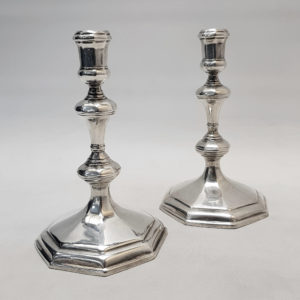
1710
Thomas Merry
10173 Queen Anne Antique Silver Candlesticks
A highly desirable pair of antique English silver candlesticks from the early 1700’s with octagonal form and baluster columns. This lovely plain style is fully in keeping with the period. Very solid cast silver. Good patina. Total weight 677 grams, 21.7 troy ounces. Height 18.8cm. Base 11.8cm wide. London 1710. Maker Thomas Merry I, specialist candlestick maker. Britannia standard silver*.
-


1712
Joseph Bird
10232 Queen Anne Antique Silver Tapersticks
A rare pair of dainty little antique silver tapersticks with the desirable octagonal shape. Superb quality. Lovely crisp finish. The straight lined form features a faceted sconce and foot and a plain knopped tapering stem. Total weight 200 grams, 6.4 troy ounces. Height 12cm. Base diameter 7.1cm. London 1712. Maker Joseph Bird. Britannia standard silver. 18th century.
-

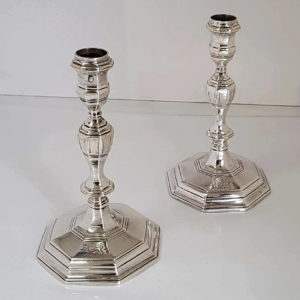
1713
Thomas Folkingham
9767 Queen Anne Antique Silver Candlesticks
Sold
A rare pair of antique English silver candlesticks from the early 1700’s. Britannia standard silver*. Very solid cast silver with octagonal form and baluster columns. Lovely plain style in keeping with the period. Each stick bears a hand engraved lion crest, for the Turnor family, on the base. Excellent colour. Weight 707 grams, 22.7 troy ounces. Height 17.5 cms. Base 10.3 cms square. London 1713. Maker Thomas Folkingham.
These make a matching set of four with #9770.
-

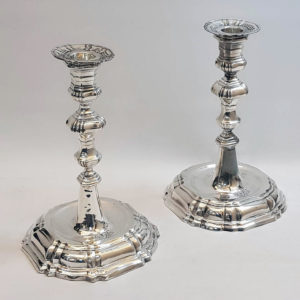
Circa 1716 - 1730
Georg Matthias Einboke
9986 Antique German Silver Candlesticks
A handsome pair of antique silver candle holders of plain, early design with knopped columns, shaped bases and detachable nozzles. Each has a monogram in old fashioned script inscribed inside the sunken well. Total weight 643 grams, 20.6 troy ounces. Height 19.8cm. Base 13cm. Braunschweig 1716-30. Maker Georg Matthias Einboke.
-


1716
George Gillingham
10418 George I Antique Silver Snuffer Tray and Scissors
It’s unusual to find a completely matching candle snuffer set from this early date, particularly with these attractive features. The scissor stand has an hour glass form, with the flat teardrop handle and small ball feet similar to early chambersticks of that date. The candle douter and wick trimmer has a simple open and shut mechanism and retains the original steel cutting plates, the pointed end was used to loosen and remove candle stubs from the socket. Both pieces bear the attractive hand engraved crest of a stallion horse.
-


1722
Matthew Cooper
10448 George I Antique Silver Taperstick
An elegant little antique silver taperstick with knopped stem and rectangular base. Classic plain style and straight lines. Hand engraved to the foot is the crest of a fleur de lys with crown below. Cast silver. Weight 101 grams, 3.2 troy ounces. Height 9.8cm, 3.8ins. Diameter of base 6.7cm, 2.6ins. London 1722. Maker Matthew Cooper. Sterling silver.
-

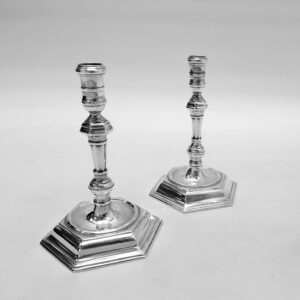
1724
John Bache
10302 George I Antique Silver Tapersticks
A delightful pair of little antique silver taper sticks with the plain hexagonal design typical of the early 1700’s. Cast silver. Total weight 235 grams, 7.5 troy ounces. Height 11.4cm. Base measures 7 x 8cm. London 1724. Maker John Bache. Britannia standard silver – 95.8% purity*. 18th century.
-

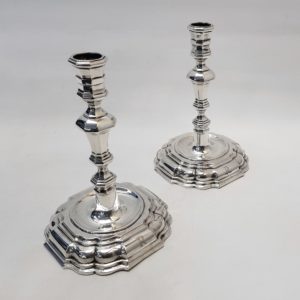
Circa 1726
10220 Antique Continental Silver Candlesticks
An early pair of solid silver candlesticks with baluster columns and spreading bases with sunken wells. This style is typical of early 18th century English candlesticks. Excellent colour. Each has a hand engraved initial “R” to the top of the base and a contemporary inscription below. Total weight 338 grams, 10.8 troy oz. Height 16cm. Diameter of base 11.1cm. Continental. Circa 1726.
-

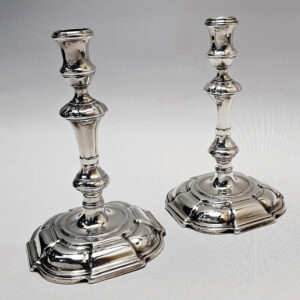
1727
James Gould
10356 George II Antique Silver Candlesticks
Reserved
A handsome pair of antique silver candle holders. Very attractive design with faceted columns and shaped bases. Heavy cast silver and good original colour. Total weight 721g, 23.1 troy ounces. Height 16.5cm. Base 10.3cm. London 1727 (first year of George II). Maker James Gould. Sterling silver.
-

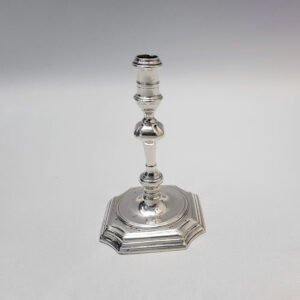
1730
John Bache
10363 George II Antique Silver Taperstick
A delightful little antique silver taper stick of plain early design with baluster stem and square octagonal foot with a sunken well. Nice plain style and straight lines. Cast silver. Hand engraved within the well is a “hand” crest. Weight 94g, 3.0 troy oz. Height 10.5cm. Base diameter 6.5cm. London 1730. Maker John Bache. Sterling silver. This taperstick would make a good pair with #10360 (minor differences).
-


1733
David Willaume
10447 George II Antique Silver Chamberstick
Reserved
A plain style silver chamber stick (or “go to bed”) from the early 1700’s with a simple C shaped handle and reeded rim. Solid design and excellent heavy gauge silver as you’d expect from this date. An unusual feature is the decorative band of trellis hatching with shells and scrolls, hand engraved to the top surface. Weight 304g, 9.7 troy oz. Diameter 13.5cm. Spread 17cm, 6.7ins. Height 6.5cm. London 1733. Maker David Willaume, an important Huguenot maker. Sterling silver.
-


1736
Peter Archambo
10445 George II Antique Silver Candlesticks
Reserved
A magnificent pair of heavy cast candlesticks with super quality decoration overall. The broad, square shaped bases have a central circular well, each of the four corners being applied with a rococo cartouche; two containing a coat of arms, the remaining two with the mask of a woman with a headdress and a man with a moustache and turban. The columns are skilfully decorated with face masks and shell corners. Total weight 1,764g, 56.7 troy oz.
Height 22.2cm, 8.74ins. Width of base 14.5cm, 5.7ins. London 1736. Maker Peter Archambo.
Sterling silver. -

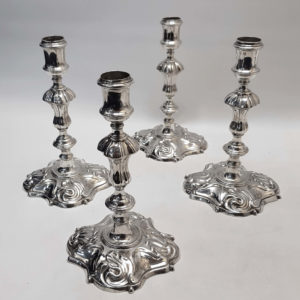
1742
William Gould
10152 Set of George II Antique Silver Candlesticks
This plain design, typical of the period, is enhanced by the unusual feature of the naturalistic shell corners. A handsome set of four antique silver candlesticks with baluster stems and shaped square bases. Heavy gauge cast silver. Each foot has a hand engraved armorial. Total weight 1,940 grams, 62.3 troy ounces. Height 19.5cm. Diameter of base 11cm. London 1742. Maker William Gould, specialist candlestick maker and great exponent of rococo silver. Sterling silver.
-


1746
9642 Antique French Silver Chamberstick
A good quality antique silver chamber stick of early form having a long flat handle and broad drip pan. With the solid cast design and excellent heavy gauge silver as you’d expect from this date. Hand engraved to the front is an armorial within a decorative cartouche (worn). Weight 217 grams, 6.9 troy oz. Diameter 10.4 cm. Length 22.5 cm. Marked underneath with French silver marks for Paris, date mark “F” for 1746. Maker’s mark indistinct.
-

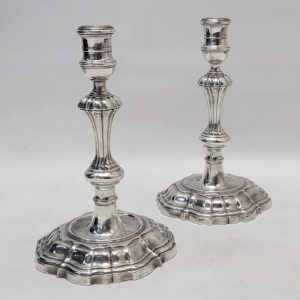
1749
David Willaume II
10146 George II Antique Silver Candlesticks
An excellent quality pair of antique silver candlesticks of baluster design with shaped bases. Heavy cast silver and good original colour. Each is hand engraved within the well of the base with an insignia containing the royal motto. Weight 1171 grams, 37.6 troy ounces. Height 21cm. Bases 12cm square. London 1749. Maker David Willaume II. Sterling silver.
-

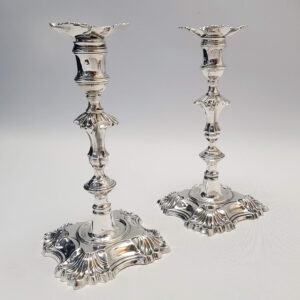
1749
William Gould
10398 George II Silver Candlesticks
Sold
An excellent pair of antique silver candle holders with shell corners and detachable sconces. Very attractive design and heavy cast silver. Weight 1042g, 33.5 troy oz. Height 21cm. Base 11x11cm. London 1749. Maker William Gould. Sterling silver.
-

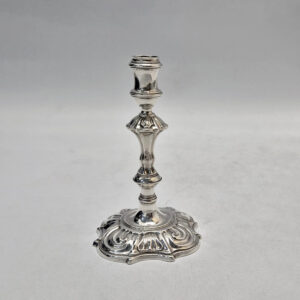
Circa 1750
10461 George II Antique Silver Taperstick
A pretty little antique silver taperstick with shaped decorative base and knopped baluster stem. Cast silver. Weight 128g, 4.1 troy oz. Height 11.9cm, 4.6ins. Base 7.7cm, 3ins. Unmarked silver. Circa 1750. Sterling silver.
-

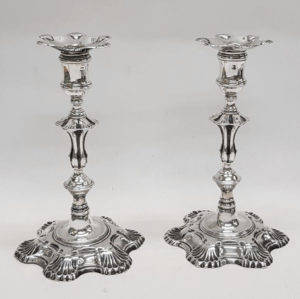
1752
John Café
9421 George II Antique Silver Candlesticks
An unusual pair of antique sterling silver candle holders with a 6 shell base and detachable sconces. Very attractive design and heavy cast silver. Hand engraved to each foot and nozzle is the crest of a winged animal over a crown (worn). Weight 1072 grams, 34.4 troy ounces. Height 22cm. Base 13.4cm. London 1752. Maker James Gould.
-

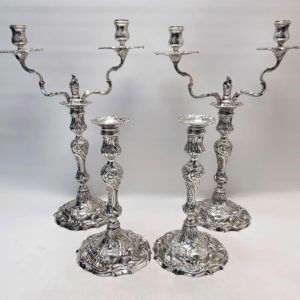
1754 - 1755
John Café
10149 George II Antique Silver Candelabra Set
Antique silver candelabra from this period are very rare and the additional pair of matching candlesticks add to the splendour of this set. A fine set of two-light silver candelabras of naturalistic rococo design with removable branches, the candlesticks with large hand engraved armorials. The four candlesticks can be used on their own. All pieces are made of heavy cast silver. Weight 4597 grams, 14 troy ounces. Height 42.5cm (top of candelabra), 27.2cm (candlestick). London 1754-55. Maker John Café, specialist candlestick maker. Sterling silver.
-


1754
Dougal Ged
10456 George II Scottish Antique Silver Chambersticks
Sold
A stunning pair of antique Scottish silver chambersticks of plain circular form with a ‘C’ shaped handle. Total weight 436g, 13.5 troy oz. Diameter 13cm, 5.1ins. Spread 14.5cm, 5.7ins. Height 6.5cm, 2.5ins. Edinburgh 1754. Maker Dougal Ged.
-

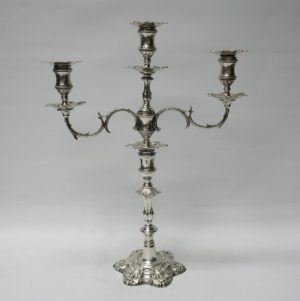
1760
John Hyatt And Charles Semore
9125 George III Silver Candlabras
Sold
A handsome pair of antique sterling silver candelabras with detachable 3 light branches and sconces. Very attractive design with a baluster stem and shaped bases with shell motifs. Heavy cast silver and good colour. The 2 branches can be assembled on one candlestick to make a 5 branch candelabra. Total weight 2755 grams, 88.5 troy ounces. Height 41.5 cm (3 branch candelabra), 48 cm (5 branch candelabra), 22.5 cms (candlesticks). Candlesticks – London 1760 by John Hyatt & Charles Semore. The candelabra branches were made later to match the candlesticks – London 1891 by Johnson Walker & Tolhurst.
-

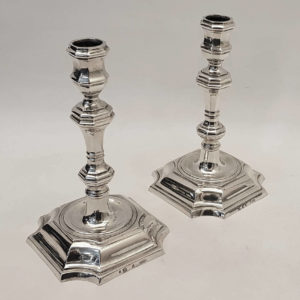
Circa 1760
Frantz Peter Bunsen
9944 German Antique Silver Candlesticks
A stunning pair of antique silver candlesticks in the plain style typical of the George II period. Very heavy quality. The classic design incorporates square bases with fluted corners, baluster stems and octagonal vase sconces. Weight 905 grams, 29 troy ounces. Height 20.5cm. Width of base 12cm. German silver marks for the town of Hanover. Maker Frantz Peter Bunsen. Date letter E, circa 1760.
-


1764
Ebenezer Coker
10451 George III Antique Silver Taperstick
A pretty little antique silver taperstick with shell base and detachable nozzle. Made of cast silver. Attractive detail with a rope twist ornament to the top and column and there is a hand engraved cypher to the sconce. Weight 170g, 5.4 troy oz. Height 13.8cm, 5.4ins. Diameter of base 8.8cm, 3.4 ins. London 1764. Maker Ebenezer Coker. Sterling silver.
-

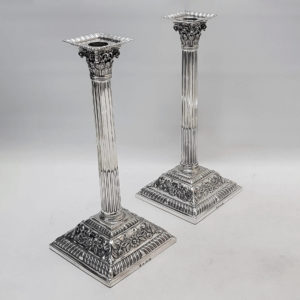
1765
William Cafe
10142 George III Antique Silver Candlesticks
Sold
A stunning pair of antique silver candlesticks of tall column form standing on square decorative bases. The pierced Corinthian capitals have excellent sharp detail, beautifully decorated with foliage and flower heads. The stepped square bases have broad gadroon borders enclosing flower and foliate ornament, and an interesting pictorial crest (worn). Removable nozzles. Solid silver with wood filled bases. Height 31.2cm. Base 13.4 x 13.4cm. London 1765. Maker William Cafe. Sterling silver.